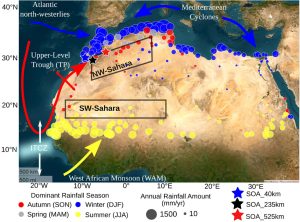- The hoary fox is the only canine endemic to both the Cerrado biome and Brazil; it’s now trying to survive among cattle pastures and soy plantations.
- Other threats resulting from human contact include road accidents, conflicts with domestic dogs, and various diseases.
- Seeking to protect the species, the Raposinha do Pontal Project combines research, conservation and community engagement on a cattle farm in Goiás state, southern Brazil.
CORUMBAÍBA, Brazil — They appeared at dusk. The day was ending in a pink-and-yellow sky when a cub moved in the grass. Its mother appeared next, red as the earth, small, slender. Krahô-Kanela is an experienced mom, having had at least four litters in her estimated six years of life. Having had numerous partners, she’s now with MacDonald, her fifth mate and stepfather to her three new pups. The cycle of life has taken away her partners and also the tip of her tail, but she’s resilient in her journey through the cattle ranches in the municipality of Corumbaíba, in Brazil’s Goiás state.
The hoary fox or hoary zorro (Lycalopex vetulus) is a small but superlative animal: the smallest canid species in Brazil, the only one endemic not only to the Cerrado but also to the country as a whole, and the only one that feeds mainly on termites. That last bit is why it inhabits the biome’s clean, open fields, where vegetation is lower and termite mounds are more visible. It usually lives in burrows dug by six-banded armadillos (Euphractus sexcinctus).
The litter is born in September, and mother and father share the tasks of raising the babies, searching for food and guarding the den to keep predators away. The pups begin to wean in December, when parental care is gradually reduced. Then father and mother no longer live in the same den with them — in fact, each one has its own — and, as the children grow older, the parents start forcing them out of their home and their territory — a natural strategy to prevent breeding among family members.
As an omnivorous species that feeds on animals and plants, the hoary fox plays a prominent role in the Cerrado, Brazil’s vast savanna biome. It eats mainly termites, but also beetles, rodents and fruits, potentially contributing to the dispersion of plant species; in Chapada dos Guimarães municipality, Mato Grosso state, a study from 1998 and another one from 2020 found that the fox may consume around 30 different plant species in natural areas. In addition to the direct relationship between the foxes and six-banded armadillos, there’s a strong correlation between rainfall, termites and hoary fox litters. Born in September, the pups emerge from their dens a month later, ready to feast on the swarm of termites caused by the start of the rainy season in October.
There are still many questions to be answered about the species, which is currently considered to be near threatened. But the threats are well known to researchers: reduction of its natural habitat; being run over on railroads and highways; persecution by and fights with domestic dogs; direct conflict with people (who shoot, poison and kill pups in their dens); and various diseases — both dog-related ones such as parvovirus infection, distemper and mange, and those derived from the wild such as leishmaniasis and tick-borne diseases. The more degraded the natural environment of the Cerrado, the more susceptible the foxes are to diseases caused by contact with people and the domestic environment.
Soybean plantations have also proved to be a threat to the species because the height and density of the crop make it difficult for the foxes to move around. Of the 11 main vegetation types of the Cerrado, categorized into savanna, forest and grassland formations, foxes occupy the so-called open fields, where the vegetation constitutes mainly native grasses and a few shrubs. In the human-transformed landscape, cattle pasture is the closest thing to this original scenario, with its grass, bushes and some trees. In recent years, however, cattle have been losing ground to soybeans, a transition that’s also brought more workers and, consequently, more domestic dogs and vehicles onto dirt roads, intensifying existing dangers.
With few conservation areas spread across a Cerrado landscape, one dominated by private lands, the hoary fox faces a challenging situation. According to a population viability analysis conducted by the Cerrado Mammal Conservation Program (PCMC), there’s an 80% probability that the hoary fox will cease to exist within 50 years. The model doesn’t say that this will happen, but its numbers are high enough to warn that the animal is sensitive to the way people use and change the environment.

Studying to save
To prevent this hypothetical situation from becoming a reality, the Raposinha do Pontal Project combines research, conservation and community engagement. On a 1,500-hectare (3,700-acre) cattle farm in the Pontal area of Goiás state, biologists and veterinarians study the behavior of hoary foxes and monitor some individuals marked with ear tags and radio collars. They want to understand the ecology and health of the species and its interactions with other wild carnivores also studied by the project, in an agroecosystem environment (a natural space modified for sustainable agriculture).
The project was created in 2020 as a partnership between the PCMC and the farm’s owner, Juscelino Martins. Though he has a “city job” as a businessman, as he puts it, Martins inherited his grandfather’s farm, the source of many fond childhood memories of family vacations. His interest in biodiversity conservation led him to create a tapir reintroduction project on the farm almost 30 years ago. Today, a drive along the nearby dirt road often yields a sighting of Tapirus terrestris, Brazil’s largest land mammal, in the surrounding forests. Increasingly interested in conservation, Martins’s focus has now turned to the hoary fox.
The PCMC is a research group linked to the Federal University of Catalão that has been conducting studies and extension work in Goiás since 2009. Its goal is to understand the relationships of some species, mainly carnivores, with human-modified areas. The information generated by its several projects, including Raposinha do Pontal, serves as a basis for decision-making by bodies such as IBAMA and ICMBio — the respective federal agencies for environmental protection and biodiversity conservation — and for state and federal action plans focused on the conservation of wild canids.
The group’s creators and coordinators are biologist couple Fernanda Cavalcanti de Azevedo and Frederico Gemesio Lemos. After meeting in Minas Gerais state’s Canastra Mountains, where Cavalcanti worked with maned wolves (Chrysocyon brachyurus), their passion for each other and for the Cerrado led the couple to focus their attention on two species that they consider very important: the puma (Puma concolor), currently the top predator in most of the Cerrado and Brazil, and the hoary fox, barely known to science until 2004.
“I started working with the hoary fox in 2002, still as an undergraduate student,” Lemos says. “When the program was created years later, the idea was to collect as much information as possible to understand a species that is exclusive to Brazil.”
And so they did. With the beginning of the PCMC, the couple launched a fox study project that would last a decade, preceding Raposinha do Pontal.
The initiative was carried out in the municipality of Cumari, in an environment similar to Martins’s farm and its cattle pastures. With the current project on the species, the idea is to replicate what has already been done to see if the ecology, behavior and threats will be repeated in another human-modified area. From their friendship with the farm’s owner and the latter’s own desire to study a genuine Cerrado animal, the conversations naturally led to the beginning of the project.

Soybeans instead of foxes
“We have been collecting interesting information about foxes since 2002, such as diet, use of space, behavior, parental care, longevity, and the threats they face in this type of human-altered landscape. By 2019, we had gathered a wealth of data that we’ve been validating in the Pontal project over the past four years,” Lemos says. “The two projects combined have provided a lot of interesting information about the species, such as parents’ role in raising their pups, but what I’d highlight is how sensitive and vulnerable this species is to the way we occupy spaces.”
Of the 53 individual foxes monitored by the Cumari project over 10 years, 45% died as a direct or indirect result of human action. The threats found there also exist on farms in the Pontal area, where foxes have been killed by vehicles, dogs and conflicts, showing that the data collected by the two projects are similar. In the last two years, on a farm next to Martins’s, soybean plantations have also emerged as another threat. The sudden change in the landscape is disturbing to the eyes and other senses: it’s impossible to go unmoved from the sounds of birds and the cool shade on the pathways in the Pontal Farm to the heat and silence in fields of newly sprouted soy.
“There was a very drastic change in the landscape in just a few months, reflecting the reality of other Cerrado areas where pastures have been turned into soybean fields at a very fast pace over the last five years,” Cavalcanti says.
By monitoring the movements of foxes fitted with collars, researchers found that they no longer frequented areas where soybeans had been introduced. “The animals stopped entering or did it sporadically when the soy plants were still small, but as soon as these plants began to grow and activity increased, they stopped using them,” Cavalcanti says. “This data gives us clues as to what is happening in the rest of the Cerrado, which used to be pasture: there were foxes, and now it is being turned into soybean plantations.”
Whether pesticides affect hoary foxes is still a question to be answered by the project, but researchers are already seeing that soy plantations displace individuals, causing loss of territory and impoverishing their food base, because no fruit grows in the middle of the plantation and no termites or beetles survive the pesticides.
“Up until 20 years ago, we used to fight for the conservation of areas against pastures. Now we are fighting for pastures against soy plantations,” Lemos says.
“And it’s not just about foxes,” Cavalcanti adds. “I believe the situation is the same for other species.”

Collars for counting animals
No one has established the size of the fox population or whether it’s decreasing or not. The only accurate figure is the number of animals of the four target species covered by the project that are being monitored. Since the beginning, the researchers have carried out 177 tranquilization procedures on 28 hoary foxes, 70 crab-eating foxes (Cerdocyon thous), three maned wolves and 11 striped hog-nosed skunks (Conepatus amazonicus), totaling 109 carnivores of different species and ages: pups, juveniles and adults. Each individual undergoes the procedure only once during the campaign, and many are recaptured over time.
Of all the animals monitored, 18 hoary foxes, 18 crab-eating foxes and two maned wolves were fitted with GPS-based radio collars. Currently, 10 animals are being observed: five hoary foxes and five crab-eating foxes. The others are no longer monitored because their collars stopped working or came loose and the animals haven’t been recaptured since to have the equipment changed or may have already died.
Two capture campaigns are carried out per year, one every six months, and each new animal that falls into the traps is fitted with an ear tag and a radio collar, which works for six to eight months in the case of hoary foxes and about a year and a half for crab-eating foxes. The project uses two types of collars: one that falls off the animal’s neck as the battery runs out, and another that stays with the animals, which must be recaptured to have it changed. To collect data from hoary fox and crab-eating fox collars, researchers need to go to the field, locate the individuals and then download the data. The collars for maned wolves send data via satellite directly to a computer.

Monitoring individuals with collars and ear tags — and capture is necessary for this purpose — allows observers to keep track of how many have joined or left the population, their health, their parasite load, and how the species use space and food resources.
“How much does the animal walk in a day, a month, or in its life? What is its birth rate? How do super-fast changes in the landscape affect animals’ parameters in terms of diet, behavior, reproduction and parental care?” Lemos says. “These are questions that we can answer by marking the individuals.”
Capture traps are set after the team finds out where they pass, through active search, fecal sample collection and camera traps.
Capturing foxes
In a typical capture campaign, the researchers begin checking the traps in the morning, driving to each one to evaluate any animals that may have fallen in. A processing table is prepared in the cargo bed of a pickup truck, where the materials to be used are placed. To begin the procedure, head veterinarian Ísis Zanini administers a tranquilizer while the animal is still in the trap. Once it’s been sedated, she takes the individual to the car and the team divides up tasks that include weighing, assessing teeth, attaching ear tags and collar, taking measurements, and collecting blood, hair and tick samples.
In the laboratory at the research center, inside the Pontal Farm, vets perform essential tests such as complete blood counts, fecal exams, and some rapid tests for seven different canine diseases. The project keeps samples from all individuals at the biobank of ICMBio’s National Center for Research and Conservation of Carnivorous Mammals (CENAP).
Some of the samples collected from each individual are sent to partner institutions such as foundations and universities, which run their own tests for pathogens and on the animals’ health and genetics. Another important partnership is with the Genomics of the Brazilian Biodiversity project, also under ICMBio and the Vale Technological Institute, which sequences the genome of dozens of Brazilian species to support conservation policies. The samples for this project were collected in the first capture campaign of 2024.

After the field procedure, which lasts about an hour, the animal is taken back to the trap and the team waits until it has fully recovered from the tranquilizer to release it. In the first days of the campaign, when several individuals usually fall into traps on the same day, procedures start with foxes and animals in less shaded areas. Throughout the campaign, as the individuals are captured, the team moves the traps to increase chances of capture.
That was how, in the second capture campaign of 2024, at the end of the year, they managed to catch Klaire, an adult female from last year’s litter. Beautiful fur, no mange, ticks or fleas (if there were any, treatment with antiparasitic drugs would be administered). Status: very healthy. Looking closely, the design at the base of every hoary fox’s tail is clear, and each animal has its own, with a unique shape that sets it apart from all other individuals of the species. Another trademark of the species as a whole is the black tip of the tail.
In this campaign, we also followed the capture of Krahô and one of her pups. The mother needed to have her collar changed. Her fur wasn’t in good condition because motherhood and breastfeeding had taken their toll. Krahô was lying calmly in the trap, in the shade of a pepper tree, and, when it was time to be released, she played the perfect model for the cameraman, slowly leaving the trap.
That same night, the family of five canines presented us with touching scenes: a baby waiting for its father at the entrance to the den, mother and father escorting the pups, the couple exchanging caresses — a rare thing to witness, according to the researchers — and, finally, MacDonald chasing us out of the area with his howl and following us to the other side of the farm fence to make sure we would leave the family alone.
Environmental education
“During fieldwork, I understood this new way of seeing the world, because their lives are much more than we imagine,” says Giulianny Machado, head of the project’s field activities. “The fox family have their organization and their division of labor, and this happens in several species.”
She says she laughs at happy things and cries at sad ones, like when she saw a puma preying on one of Krahô’s former partners. “I want to make a difference in the project so that 50 years from now there will still be foxes in the field and today’s children will look after the species.”
Staying at the research base for at least 15 days a month since 2020, Machado has become part of the local community, with whom she talks during her displacements at work and through the messaging group on her phone, where she receives stories and photos from residents about animals they see and occasionally rescue in their rural everyday lives. Based on conversations with children during rides in the school van and also at the masses that take place once a month on each farm, she says people’s perception of foxes and other animals has changed because of the project.
“If we don’t build bridges, people will lose their ability to be amazed,” Lemos says. The project’s next bridge will be a children’s book about hoary foxes, to be donated to schools in Corumbaíba and neighboring towns. It will be the project’s first systematic environmental education activity, but the doors have already been opened a piece of exciting news: the hoary fox has become the mascot of the Federal University of Catalão.

“We are engaging the community through environmental education and contacts. And this engagement will eventually enable us to conserve the animals,” says biologist Juliana Martins, the project’s manager and Juscelino Martins’s daughter. “The project’s dream is to become a research hub for conservation in the Cerrado.”
To this end, the next steps include expanding the research to other species such as birds, building ecological corridors between farms to connect fragments of vegetation, and creating a guide for good management practices on farms, following the example of Pontal.
Ensuring there are no domestic dogs, no pesticides, plenty of termite mounds, a high proportion of preserved native vegetation, and reforestation of native seedlings are the methods used by Juscelino Martins on his farm to help the local fauna survive.
“I have always believed that it is possible to establish best practices and have good production without the risk of degradation. I do think it is important to make a profit; what I don’t see as necessary is making a profit at any cost in the longer term. We can have profitable production without putting too much pressure on the environment, because there are many practices, many technologies, many possibilities,” he says.
Coexistence with one’s wild neighbors is good, he adds, and as the project generates more information, “it becomes easier to dispel myths and prejudices and help people think more sustainably.”
We spot a wealth of these neighbors: peccaries, giant anteaters, six-banded armadillos, greater rheas, seriemas, capuchin monkeys, toucans, rufous-tailed jacamars, calango lizards, ameiva lizards, tayras, two baby striped hog-nosed skunks wrestling in the grass — also rare, according to researchers — and so many other species within a radius of a few kilometers in just a few days.
This is evidence that production and conservation can be complementary rather than mutually exclusive. With respect and care, all living beings can prosper, with their inherent right to life preserved.
“I dream that the fox will be able to live in the spaces where it has always been since its emergence as a species, fearing only what is natural, without our species intensifying these fears to a level that makes life much less magical,” Lemos says.
“All species are valuable and deserve to be here,” Cavalcanti says. “I wish for the fox what I wish for myself: to be alive, to be well, to have quality of life, to be as respected as any other species, including ourselves.”
In the parallels of life during fieldwork, the life of the fox family is reflected in the family of researchers that was formed around this project, with the partnership, shared tasks and challenges of daily management. In the struggle to survive the growing threats, the foxes mirror the researchers’ struggle for the right of the species to coexist in an agroecosystem. In their words, the resilience and simplicity of the hoary fox show that it may be small in size, but its capacity for survival is great.
Banner image: The tag on the right ear indicates a male hoary fox. Currently being monitored with a radio collar, this is MacDonald, keeping an eye on movements in the field to protect his cubs. Image by Augusto Gomes.
This story was first published here in Portuguese on Jan. 20, 2025.
Citations:
Dalponte, J. C., & Lima, E. D. (1999). Fruit availability and the diet of Lycalopex vetulus (Carnivora – Canidae) in a Cerrado vegetation of Mato Grosso, Brazil. Revista Brasileira de Botânica, 22, 325-332. doi:10.1590/S0100-84041999000500015
Cisneiro, A. C. (2020). Dieta e dispersão de sementes por lycalopex vetulus (LUND, 1842) em áreas de cerrado stricto sensu do município de Chapada Dos Guimarães, Mato Grosso, Brasil (Master’s thesis, Federal University of São Carlos, São Carlos, Brazil). Retrieved from https://repositorio.ufscar.br/handle/ufscar/13184
Carvalho-Roel, C. F., Azevedo, F. C., Freitas-Junior, M. C., Candeias, I. Z., Marçal Junior, O., & Lemos, F. G. (2024). How risky is to live among us? Assessing the population viability of two South American wild canids in an agroecosystem. Biological Conservation, 299, 110805. doi:10.1016/j.biocon.2024.110805
This story was first published here in Portuguese on Jan. 20, 2025.









